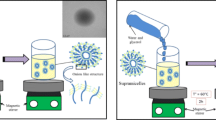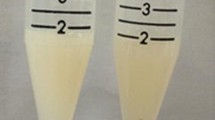Abstract
The aims of this work were to develop a novel vesicular carrier, procyanidins, ultradeformable liposomes (PUDLs), to expand the applications for procyanidins, and increase their stability and transdermal delivery. In this study, we prepared procyanidins ultradeformable liposomes using thin film hydration method and evaluated their encapsulation efficiency, vesicle deformability, storage stability, and skin permeation in vitro. The influence of different surfactants on the properties of PUDLs was also investigated. The results obtained showed that the PUDLs containing Tween 80 had a high entrapment efficiency (80.27 ± 0.99%), a small particle size (140.6 ± 19 nm), high elasticity, and prolonged drug release. Compared with procyanidins solution, the stability of procyanidins in PUDLs improved significantly when stored at 4, 25, and 30°C. The penetration rate of PUDLs was 6.25-fold greater than that of procyanidins solution. Finally, the results of our study suggested that PUDLs could increase the transdermal flux, prolong the release and improve the stability of procyanidins, and could serve as an effective dermal delivery system for procyanidins.








Similar content being viewed by others
References
Kelm MA, Johnson JC, Robbins RJ. High-performance liquid chromatography separation and purification of cacao (Theobroma cacao L.) procyanidins according to degree of polymerization using a diol stationary phase. J Agr Food Chem. 2006;54:1571–6.
Yamakoshi J, Saito M, Kataoka S. Safety evaluation of proanthocyanidin-rich extract from grape seeds. Food Chem Toxicol. 2002;40:599–607.
Serrano J, Puupponen-Pimiä R, Dauer A. Tannins: current knowledge of food sources, intake, bioavailability and biological effects. Mol Nutri Food Res. 2009;53:S310–29.
Joshi SS, Kuszynski CA, Bagchi M, Bagchi D. Chemopreventive effects of grape seed proanthocyanidin extract on Chang liver cells. Toxicology. 2000;15:83–90.
Yu J, Ahmedna M, Goktepe I. Potential of peanut skin phenolic extract as antioxidative and antibacterial agent in cooked and raw ground beef. Int J Food Sci Tech. 2010;45:1337–44.
Yamakoshi J, Saito M, Kataoka S. Procyanidins-rich extract from grape seeds prevents cataract formation in hereditary cataractous (ICR/f) rats. J Agr Food Chem. 2002;50:4983–8.
Pinent M, Blay M, Blade MC. Grape seed-derived procyanidins have an antihyperglycemic effect in streptozotocin-induced diabetic rats and insulinomimetic activity in insulin-sensitive cell lines. Endocrinology. 2004;145:4985–90.
Pallarès V, Calay D, Cedó L. Additive, antagonistic, and synergistic effects of procyanidins and polyunsaturated fatty acids over inflammation in RAW 264.7 macrophages activated by lipopolysaccharide. Nutrition. 2012;28:447–57.
Dinicola S, Cucina A, Pasqualato A. Antiproliferative and apoptotic effects triggered by grape seed extract (GSE) versus epigallocatechin and procyanidins on colon cancer cell lines. Int J Mol Sci. 2012;13:651–64.
Meyer AS, Yi OS, Pearson DA. Inhibition of human low-density lipoprotein oxidation in relation to composition of phenolic antioxidants in grapes (Vitis vinifera). J Agr Food Chem. 1997;45:1638–43.
Sudheer KM, Santosh KK. Grape seed proanthocyanidins inhibit UV-radiation-induced oxidative stress and activation of MAPK and NF-κB signaling in human epidermal keratinocytes. Free Radical Bio Med. 2006;40:1603–14.
Cinta B, Gerard A, Anna AA, Begoña M, et al. Proanthocyanidins in health and disease. Fitoterapia. 2016;42:5–12.
Davidov-Pardo G, Arozarena I, Marín-Arroyo MR. Stability of polyphenolic extracts from grape seeds after thermal treatments. Eur Food Res Technol. 2011;232:211–20.
Panchognula R. Transdermal delivery of drugs. Indian J Pharmocol. 1997;140:140–56.
Cevc G. Lipid vesicles and other colloids as drug carriers on the skin. Adv Drug Deliver Rev. 2004;56:675–711.
Cosco D, Celia C, Cilurzo F. Colloidal carriers for the enhanced delivey through the skin. Expert Opin Drug Del. 2008;5:737–55.
Gangwar M, Singh R, Goel RK. Recent advances in various emerging vescicular systems: an overview. Asian Pac J Trop Med. 2012;2:S1176–88.
Nandure HP, Puranik P, Giram P, Lone V. Ethosome: a novel drug carrier. Int J Pharm Res Allied Sci. 2013;2:18–30.
El Maghraby GMM, Williams AC, Barry BW. Drug interaction and location in liposomes: correlation with polar surface areas. Int J Pharm. 2005;292:179–85.
Abdellatif AA, Tawfeek HM. Transfersomal nanoparticles for enhanced transdermal delivery of clindamycin. AAPS PharmSciTech. 2015. doi:10.1208/s12249-015-0441-7.
Garg V, Singh H, Bhatia A, Raza K, Singh SK, Singh B, et al. Systematic development of transethosomal gel system of piroxicam: formulation optimization, in vitro evaluation, and ex vivo assessment. AAPS PharmSciTech. 2016. doi:10.1208/s12249-016-0489-z.
Liu D, Hu HY, Lin ZX, Chen DW, Zhu YY, et al. Quercetin deformable liposome: preparation and efficacy against ultraviolet B induced skin damages in vitro and in vivo. J Photoch Photobio B. 2013;127:8–17.
Ascenso A, Raposo S, Batista C, Cardoso P, Mendes T, Praça FG, et al. Development, characterization, and skin delivery studies of related ultradeformable vesicles: transfersomes, ethosomes, and transethosomes. Int J Nanomed. 2015;10:5837–51.
Elhissi AMA, Giebultowicz J, Stec AA. Nebulization of ultradeformable liposomes: the influence of aerosolization mechanism and formulation excipients. Int J Pharm. 2012;436:519–26.
Chaudharya H, Kohlib K, Kumara V. A novel nano-carrier transdermal gel against inflammation. Int J Pharm. 2014;465:175–86.
Shammaa RN, Elsayed I. Transfersomal lyophilized gel of buspirone HCl: formulation, evaluation and statistical optimization. J Liposome Res. 2013;23:244–54.
The United States Pharmacopeial Convention. Maritime Pine Extract: Maritime Pine Extract is prepared from the pulverized Maritime Pine using suitable solvents. It contains between 65 and 75 percent of procyanidins, calculated on the dried basis. United States Pharmacopoeia. 2008;32:1050–1.
Cevc G, Gebauer D, Stieber J. Ultraflexible vesicles, Transfersomes, have an extremely low pore penetration resistance and transport therapeutic amounts of insulin across the intact mammalian skin. BBA-Biomembranes. 1998;1368:201–15.
Khan MA, Pandit J, Sultana Y, Sultana S, Ali A. Novel carbopol based transfersomal gel of 5-fluorouracil for skin cancer treatment: in vitro characterization and in vivo study. Drug Deliv. 2015;22:1–8.
Montanari J, Roncaglia DI, Lado LA. Avoiding failed reconstitution of ultradeformable liposomes upon dehydration. Int J Pharm. 2009;372:184–90.
International Conference on Harmonisation of Technical Requirements for Registration of Pharmaceuticals for Human Use. Stability testing of new drug substance and product. ICH Topic Q1A (R2). 2003;9–23.
Chinese Pharmacopoeia Commission. The guidance for the stability test of active pharmaceutical ingredient and dosage forms. Pharmacopoeia of the People’s Republic of China 2015 Edition IV. 2015;354–6.
Organisation for Economic Co-operation and Development. Guidance document for the conduct of skin absorption studies. OECD series on testing and assessment: number 28. 2004;11–30
Betz G, Nowbakht P, Imboden R, Imanidis G. Heparin penetration into and permeation through human skin from aqueous and liposomal formulations in vitro. Int J Pharm. 2001;228:147–59.
Kuan YC, Lee WT, Hung CL, Yang C, Sheu F. Investigating the function of a novel protein from Anoectochilus formosanus which induced macrophage differentiation through TLR4-mediated NF-κB activation. Int J Immunopharmacol. 2012;14:114–20.
Rice-Evans CA, Miller NJ, Paganga G. Structure-antioxidant activity relationships of flavonoids and phenolic acids. Free Radical Bio Med. 1996;2:933–56.
Gao Y, Chen L. Nanohybrid systems of non-ionic surfactant inserting liposomes loading paclitaxel for reversal of multidrug resistance. Int J Pharm. 2012;422:390–7.
Jain S, Jain P, Umamaheshwari RB. Transfersomes-a novel vesicular carrier for enhanced transdermal delivery: development, characterization, and performance evaluation. Drug Dev Ind Pharm. 2003;29:1013–26.
Tasi LM, Liu DZ, Chen WY. Microcalorimetric investigation of the interaction of polysorbate surfactants with unilamellar phosphatidylcholines liposomes. Colloid Surface A. 2003;213:7–14.
Pawlikowska-Pawlega B, Gruszecki WI, Misiak L, et al. Modification of membranes by quercetin, a naturally occurring flavonoid, via its incorporation in the polar head group. BBA Biomembrane. 1768;2007:2195–204.
Wojtowicz K, PawlikowskaPawlega B, Gawron A, Misiak LE, Gruszecki WI. Modifying effect of quercetin on the lipid membrane. Folia Histochem Cytobiol. 1996;34:48–50.
Jatha J, Mishra AK. Effect of ionic and neutral surfactants on the properties of phospholipid vesicles: investigation using fluorescent probes. J Photoch Photobio. 1997;104:173–8.
El Maghraby GMM, Williams AC, Barry BW. Skin delivery of oestradiol from lipid vesicles: importance of liposome structure. Int J Pharm. 2000;204:159–69.
Deng Q, Yue Y, Hu X, Hou X. The interaction between ultraflexible nano-liposome of salmon calcitonin and surfactants. Chinese J New Drug. 2003;12:924–7.
vanden Berge BA, Wertz PW, Junginger HE, Bouwstra JA. Elasticity of vesicles assessed by electron spin resonance. Electron microscopy and extrusion measurement. Int J Pharm. 2001;217:13–24.
Li M, Li YJ, Liu WW, Li RL, et al. The preparation of Cistanche phenylethanoid glycosides liquid proliposomes: optimized formulation, characterization and proliposome drip** pills in vitro and in vivo evaluation. Eur J Pharm Sci. 2016. doi:10.1016/j.ejps.2016.07.020.
Song CK, Balakrishnan P, Shim CK. A novel vesicular carrier, transethosome, for enhanced skin delivery of voriconazole: characterization and in vitro/in vivo evaluation. Colloid Surf B. 2012;92:299–304.
Kirjavainen M, Mönkkönen J, Saukkosaari M. Phospholipids affect stratum corneum lipid bilayer fluidity and drug partitioning into the bilayers. J Control Release. 1999;58:207–14.
Honeywell-Nguyen PL, De Graaff AM, Groenink HWW. The in vivo and in vitro interactions of elastic and rigid vesicles with human skin. BBA-Gen Subjects. 2002;1573:130–40.
Acknowledgements
We thank the Tian** Jianfeng Natural Product R&D Co., Ltd., China, for supplying us with procyanidins.
Author information
Authors and Affiliations
Corresponding author
Ethics declarations
Conflict of Interest
The authors declare that they have no conflict of interest.
Rights and permissions
About this article
Cite this article
Chen, R., Li, R., Liu, Q. et al. Ultradeformable Liposomes: a Novel Vesicular Carrier For Enhanced Transdermal Delivery of Procyanidins: Effect of Surfactants on the Formation, Stability, and Transdermal Delivery. AAPS PharmSciTech 18, 1823–1832 (2017). https://doi.org/10.1208/s12249-016-0661-5
Received:
Accepted:
Published:
Issue Date:
DOI: https://doi.org/10.1208/s12249-016-0661-5




